
Have you ever wondered why all the buzz around olive oil? Firstly, extra virgin olive oil (EVOO) contains higher levels of natural phenols than its counterparts, as it is the least processed form of olive oil. Phenols, like monounsaturated fat, can contribute to maintaining optimal blood lipid levels, including cholesterol and triglycerides. Secondly, a single serving of EVOO amounts to roughly 70% oleic acid, a type of fatty acid that can support heart health. Studies suggest that incorporating oils rich in oleic acid, such as olive oil, into your diet can reduce the risk of coronary artery disease. However, it's important to consume these oils in moderation to avoid adding too many calories to your meals. A great way to do this is by replacing the fats you currently use with olive oil.
Olive oil is also the perfect addition to a healthy salad filled with nutritious fruits and vegetables. Making a simple oil and vinegar dressing allows you to control the ingredients, including salt and fat. Creating a fresh salad dressing from common kitchen ingredients is easy and quick - just a couple of shakes or whisks and you're done.
Here are tips to make a basic olive oil dressing using the general guidelines for a classic French vinaigrette:
- A classic French vinaigrette is typically 3 to 4 parts oil (usually extra virgin olive oil) and 1 part acid (frequently red wine vinegar). Example: 3-4 tablespoons of olive oil to 1 tablespoon of vinegar.
- Seasonings include salt, pepper (freshly ground) and often Dijon mustard and/or garlic.
- Start experimenting by beginning with 3 parts oil to 1 part vinegar or citrus juice. You may be able to use less oil and more vinegar/juice to cut down on calories if you select a mild acid ingredient such as rice vinegar, white wine vinegar, fruit vinegar (e.g., raspberry or blueberry), champagne vinegar or lemon, lime or orange juice. While lime and lemon juice can stand alone in salad dressings, you'll get more flavor by combining orange juice with vinegar.
- For a better flavor, make sure the oil and vinegar are thoroughly mixed. The standard procedure is to whisk the vinegar with the salt, pepper and any other seasonings. Then, add the oil in a slow stream, whisking constantly, until dressing is translucent. Or, shake the ingredients together in a small jar with a tight-fitting lid. If not using the dressing right away, whisk or shake again before using as the ingredients tend to separate when not mixed.
- Plan to use about 1 Tablespoon of oil/vinegar dressing per two cups of salad. Dress, don't drown, your salad to keep the calories lower. Salad dressing sticks better to dry lettuce and you will be able to save calories by using less dressing. Use a salad spinner or dry your lettuce between two layers of paper towels.
Basic Oil/Vinegar Salad Dressing
Directions (adjust amounts given in table below according to personal taste)
- Whisk together vinegar and any additional seasonings or flavorings.
- Slowly add olive oil and whisk in. Or, shake all ingredients together in a small jar with a tight lid.
- Refrigerate any leftover dressing and use within 2-3 weeks.
| Ingredients: | For 1 main dish (2-cup) or 2 side dish salads (1-cup each) | For 2 main dish (2-cups each) or 4 side dish salads (1-cup each) |
|---|---|---|
| Balsamic, red wine or white wine vinegar, lemon juice, lime juice or combination of vinegar/orange juice | 1 teaspoon | 2 teaspoons |
| Salt & freshly ground black pepper | To taste | To taste |
| Extra virgin olive oil | 1 Tablespoon | 2 Tablespoons |
| Optional Seasonings: | ||
| Minced sweet onion | 1 ½ teaspoons to 1 tablespoon | 1 to 2 Tablespoons |
| Dijon-type mustard | ¼ to scant ½ teaspoon | ½ to 1 teaspoon |
| Garlic powder or clove of minced garlic | Dash of garlic powder OR 1 very small clove of garlic, minced | 1/8 teaspoon powder OR 1 clove, minced |
| Sugar | A pinch or to taste | A pinch or 2 OR to taste |
| Chopped fresh herbs (e.g., oregano, thyme, tarragon, parsley) | 1 ½ or more teaspoons | 1 or more Tablespoons |
Choosing, Storing and Using Extra Virgin Olive Oil
Choosing - When shopping for olive oil, the UC Davis Olive Center recommends looking for containers made from tinted glass, tin, or clear glass covered by a large label or placed in a box. To enjoy olive oil at its best, the North American Olive Oil Association recommends purchasing an amount that will be finished in about 8-10 weeks after being opened. If you limit exposure to light, heat and air, it will likely maintain a satisfactory quality beyond this.
Storing - Keep olive oil in a cool, dark place, such as inside a cupboard in a cooler location away from the stove and oven. It is best to store olive oil between 55-60 degrees Fahrenheit to avoid it from becoming rancid. Refrigeration will cause olive oil to become cloudy and harden. Olive oil returns to its normal color and consistency when returned to room temperature. If you bought olive oil in bulk, you may wish to refrigerate a portion to prolong its quality until you're ready to use it. For example, keeping a small jar of olive oil in a cupboard to have for quick use and keeping the rest of the olive oil in the refrigerator would be an easy way of keeping the olive oil's quality longer.
Using - EVOO, because of its more pronounced flavor compared to other forms of olive oil, is most often used to flavor salads and dressings; as a base for marinades; and is drizzled on foods, such as pasta, just before they are served. The flavor profile of EVOO varies from robust to more subtle and fruity. Additionally, there are other flavors of olive oil that you can choose from when selecting EVOO at the grocery store, such as garlic or herb flavored. Match the flavor to the ingredients — red meat, for example, may support a more intense flavor. More delicate foods, such as white fish and veggies, may pair better with a milder EVOO.
Sources:
Buying Olive Oil, North American Olive Oil Association
Cooking Uses by Type, North American Olive Oil Association
FDA Completes Review of Qualified Health Claim Petition for Oleic Acid and the Risk of Coronary Heart Disease, Food and Drug Administration (FDA), November 19, 2018.
Ten Myths and Facts About Olive Oil, UC Davis Olive Center
This article was originally written by Alice Henneman. It was reviewed and updated by Dani Higgins, Professional Student of Dietetics, University of Nebraska-Lincoln.
Tags:







